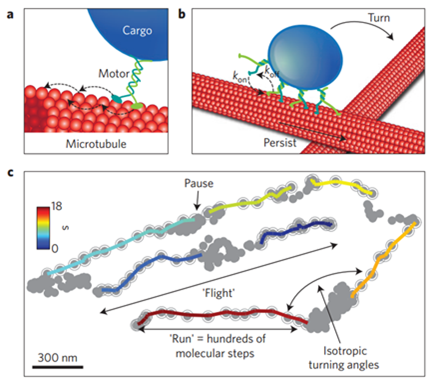Researchers discover how nature enables cells to act intelligently

Researchers at the Institute for Basic Science (IBS) have discovered a Lévy walk pattern of movement when living cells eat. When the food is transported within the cell by so-called endosomal active transport, it is the same mathematical pattern of movement that many animals follow when foraging for food.
A Lévy walk or flight, named after a French mathematician Paul Lévy, is a mix of long trajectories and short random movements. Numerous short movements are made within a small area, and occasionally a long stride to a distant area, where the action is repeated. This particular motion pattern is observed in humans and animals.
While scientists had previously studied the pattern in humans and animals of inherent intelligence, this research is the first to identify this pattern of movement in molecular motors.
Steve Granick, Director of the IBS Center for Soft and Living Matter and one of the authors of the research, explained why it's so interesting and important. "We didn't want to repeat what other people did in the past. People knew that jellyfish, sharks, birds, and people can execute this important process (Lévy walk). We discovered that even molecules without a brain can do the same thing. And we discovered the secret of how it's accomplished."
Molecular motors are responsible for the intracellular transport of many cargoes. The researchers observed how these motors carry cargo (endosome) as they move along microtubules, an intracellular highway network.
The rule they discovered is this. When molecular motors carry cargo, their purpose is to find a destination. They thoroughly explore their immediate environment. If a destination is not found, they travel further, repeating the action until a destination is found. "Nature is more clever than we are. It finds this efficient way to engineer this marvelous result without being smart, without (using any pre-existing) memory, and it saves them energy" added Director Granick.
"The findings of our study may help us to better understand our cells and how our body is engineered" he went on. "At the IBS Center for Soft and Living Matter in Korea, the rule we discovered holds promise to engineer new kinds of artificial active materials."
More information: "Memoryless self-reinforcing directionality in endosomal active transport within living cells," Nature Materials, DOI: 10.1038/nmat4239
Journal information: Nature Materials
Provided by Institute for Basic Science




















